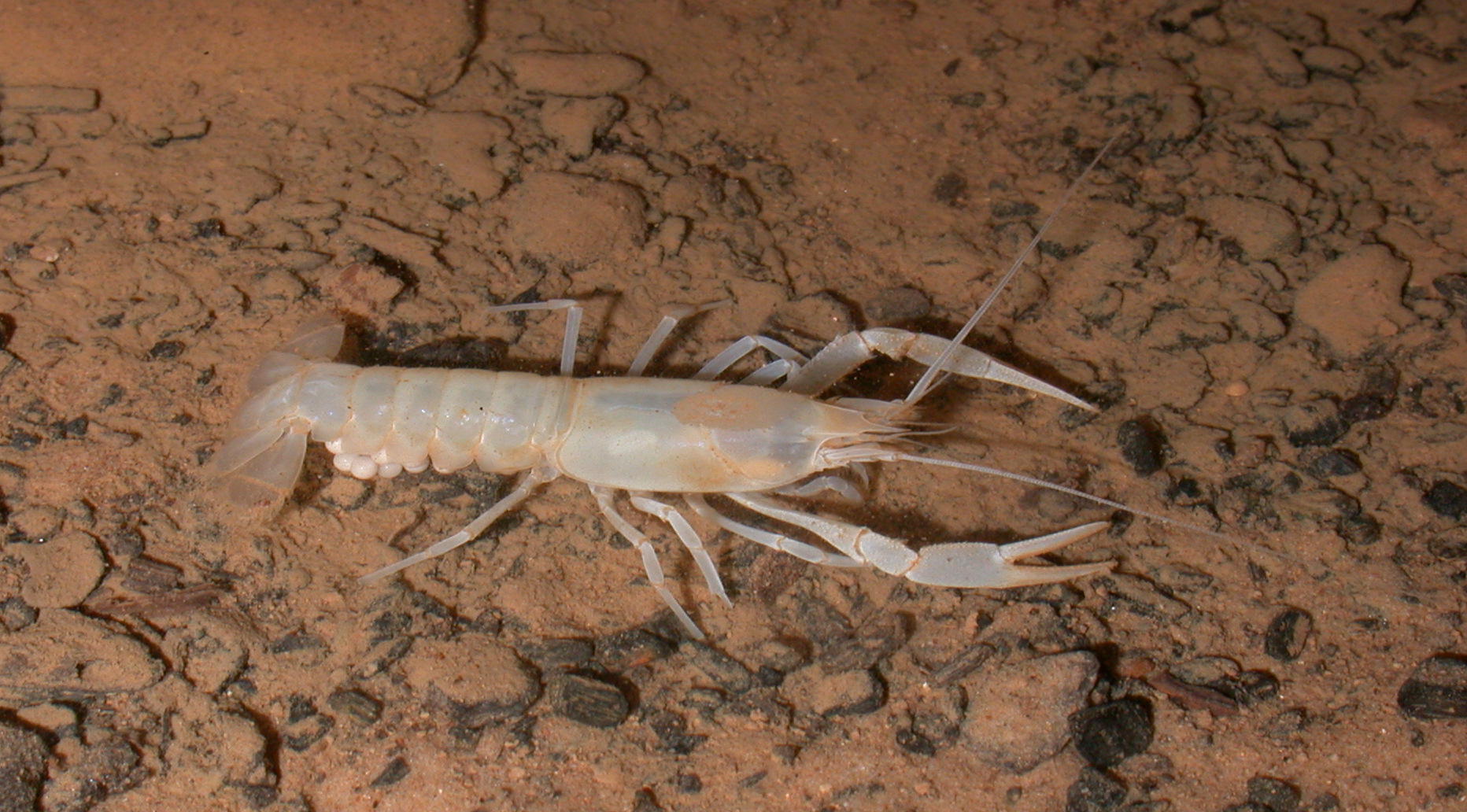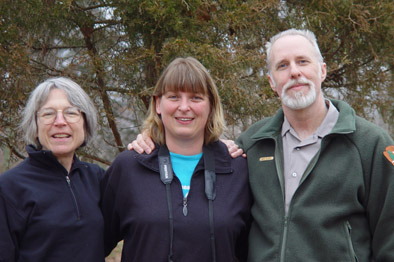Introduction

Booths Amphitheatre in Mammoth Cave, showing a section of the entrance passage near the saltpetre mining site. Photo: M. Thurgate.
Mammoth Cave is a globally significant karst site with many important cultural, biological and geological values. This has been recognised by a listing in 1981 as a World Heritage area and in 1990 it became the focal point of an International Biosphere Reserve. The values of Mammoth Cave are summarised below.
- Indigenous culture: Archaeological sites dating back to 4000 years before present are found within Mammoth Cave. These sites provide information about the use of the caves as a source of minerals by American Indians. Artefacts such as fragments of reed torches, gourds, sandals and even a 2500 year old wooden scaling pole are preserved deep in the cave system.
- European culture: Inside the caves are the remains of a mining operation which produced saltpetre for gunpowder supplies for the War of 1812. At the end of the war, saltpetre prices plummeted, and the mining operation was replaced by cave tourism. Nearby is an extensive display of historic signatures - many dating back to the cave visitors and explorers of the mid 1800s. Ruins of an experimental underground Tuberculosis Hospital from 1842 are also present.
- Biodiversity: Over 130 species, which are regular inhabitants of park caves, have been identified that are partially or wholly cave-dependent. These include cave fish, many crustaceans (amphipods, isopods, and crayfish), spiders, cave crickets, beetles, millipedes and flatworms. One special species is the Kentucky Cave Shrimp, which is endemic to the Mammoth Cave area and listed as endangered. Bats utilise caves within the National Park including two endangered species, which are the Indiana and Gray bats.
Surface environments are support a rich diversity of animals and plants. The Green River which runs through the park contains over 80 species of fish and 50 species of freshwater mussels, six of which are listed as endangered. - Geology/geomorphology: Mammoth Cave is the longest known cave in the world (over 580 kilometres of passage and still going). There are up to six different levels of cave passage in four main ridges. Important fossil and other cave deposits and many areas of unusual mineral deposits have been found in different parts of the system.
Mammoth Cave National Park is managed by the US National Park Service. The park covers an area of over 21 000 hectares. Nearly 2 million people visit the caves each year, and many of these experience at least one of the 13 guided cave tours. These tours provide access to over 16 kilometres of passage. Not surprisingly, the National Park is also a focal point for caving groups who are involved in exploration, mapping and conservation projects. The park is popular for a range of outdoor recreational pursuits including fishing, canoeing, hiking and camping.
The area surrounding the park has been largely cleared and land uses include agriculture, tourism and rural, industrial and urban development. A number of private commercial cave operations are also found in the area.
 |
 |
| A blind crayfish in Mammoth Cave Photo: M. Thurgate. | Mia Thurgate (centre) with Rick Olsen and Peggy Palmer (Peggy is well-known cave explorer who has done a lot of research at Mammoth). Photo: M. Thurgate. |
All of this adds up to a very complex management situation. This article focuses on the management issues currently being addressed within the National Park.
Changes to the entrance passage
The original entrance passage to Mammoth Cave, known as Houchins Narrows, has been periodically modified over the past 180 years. The entrance passage has been excavated, so that in places it is more than double its original height. The cave floor has been smoothed and altered to make way for paths. Masonry walls and gates that restricted airflow were installed to protect the cave from unauthorised entry, and to moderate the temperature within during winter.
While these changes have made access to the cave easier for tour groups, they have caused a change in cave air flows and climatic conditions. Most notably there had been an increase of cold air into the cave in winter in some sections, while in other areas natural airflows have been restricted by infrastructure. As a result:
- The millions of bats that once used the cave as an over-wintering site have abandoned the cave. Disturbance from cave tour groups and unsuitable gating (prior to 1990) have compounded this problem. Woodrats that once lived in the loose rocks on the floor of the entrance passage have also abandoned the cave. Some terrestrial invertebrate communities have also been displaced.
- Increased moisture due to condensation is now found in places it did not naturally occur. In periods of colder than average weather this has allowed moisture to freeze between bedding planes causing localised rock falls. Fallout of fine sulphate salts from the roof in some sections of the cave has also increased.
- Increased moisture levels have allowed fungal growth to develop on wooden artefacts from the indigenous archaeological sites, threatening their long-term survival. This problem was observed over two kilometres into the cave from the Historic Entrance.
- Since 1989 cold winter air entering through the Historic Entrance has mixed with warmer moist air flowing from Gothic Avenue. A cloud forms at the ceiling level and water collects on all surfaces in contact with the cloud. This condensation drips onto War of 1812 saltpetre leaching vats below, and has promoted active fungal growth. Restriction of airflow through the gate by application of plexiglass panels in 1996 has significantly reduced this problem.
Work is now underway at Mammoth Cave to restore air flows and climate to original conditions. A major hurdle to be overcome in this restoration process has been the lack of historical data about what conditions in the cave were like before entrance modifications commenced. Palaeontological information is being used to develop a more detailed history of changes to the entrance passage.
Bat deposits are being investigated to find out which species used the cave as an over-wintering site, and how many bats were involved. Current research suggests that six species of bats used the cave in the past.
At least 9-13 million bats (mostly Gray and Indiana bats) hibernated in areas that are now used as main tour routes. This figure is a conservative estimate. The two main bat species have very narrow temperature range preferences. This provides the staff at Mammoth Cave with target temperate range for climate restoration work.
Other measures to make the cave more attractive to bats include:
- Restriction of access to the cave by visitors at the critical times of dusk and dawn
- Reconfiguration of entrance lighting to be less intrusive
- Rerouting of cave tours to leave some areas free of disturbance
Plexiglass baffles were installed on the entrance gate in March of 1996. Winter cave temperatures can be manipulated by the use of these baffles so that temperatures are approaching the range required by the endangered Indiana bats.
Three additional management issues have been improved by controlling winter cave temperatures. First, the rock fall rate has been dramatically reduced. From 1994-95, six rock falls were recorded in the cave.
Since the baffles were installed, only one rock fall has occurred. Secondly, fungal growth on indigenous artefacts has become dormant. Finally, based upon field observations, condensation dripping on the saltpetre leaching vats at Booth's Amphitheatre has been greatly reduced.
Park staff is now working to eliminate condensation completely. During the winter of 2002, a section of passage was blocked to prevent the mixing of warm and cold air flows above the saltpetre mining site. The passage was blocked using plastic sheeting attached to a timber frame. The frame was custom made to fit the narrowest part of the passage and was wedged into place to prevent damage to the limestone. This structure can be easily dismantled and removed. The barrier was effective in reducing condensation levels to extremely low levels. Further refinement of the technique along with other restoration activities should eliminate the problem in the near future.
Dust and Lint
Historically, paths in Mammoth Cave were built of cave sediment which was mined from the cave. The historic paths were vulnerable to drying in winter, and dust raised by tours was suspended in the air, mixed with lint from visitors, and then settled on features near the paths.
In 1960s and 1970s water was applied to the paths to control dust and calcium chloride and ammonium nitrate were added to retain the moisture. The effect of these chemicals on the cave environment is unknown, but it is likely that there were impacts on water quality and cave invertebrates.
These management practices are no longer in use at Mammoth Cave, but the legacy of the past needs to be repaired. New paths are being installed that are made of concrete or recycled plastic lumber. Lint curbs have been added to capture low-level dust and lint. Finally, the surfaces of many formations are being hand cleaned with brushes to remove lint and dust.
Cave infrastructure
Sections of the historic paths near the River Styx include raised wooden boardwalks and platforms. These are also being colonised by fungal communities, and may have introduced an unnatural food supply into the cave, upsetting the ecological balance of invertebrate populations. Of greater concern is the fact that the wood was treated with creosote, which was leaching into the underground stream.
A lighting system from the 1960s also started to corrode and was polluting waterways. These pollutants have probably impacted on aquatic ecosystems which support the endangered Kentucky Cave Shrimp.
To prevent further decline in water quality, the wooden pilings and decking and old lighting system are being manually dismantled and are being carried out of the cave. This has been a massive operation and has relied on volunteer efforts coordinated by the National Speleological Society. As an example of the effort involved, over 300 metres of boardwalk has been dismantled and removed to date.
Conclusion
The goal of management efforts at Mammoth Cave is to realise a long-term, holistic management strategy that truly protects the world-class natural and cultural resources.
There have already been a number of positive outcomes, and major achievements can be recognised. However this is a long-term process with many difficult problems still to be solved.